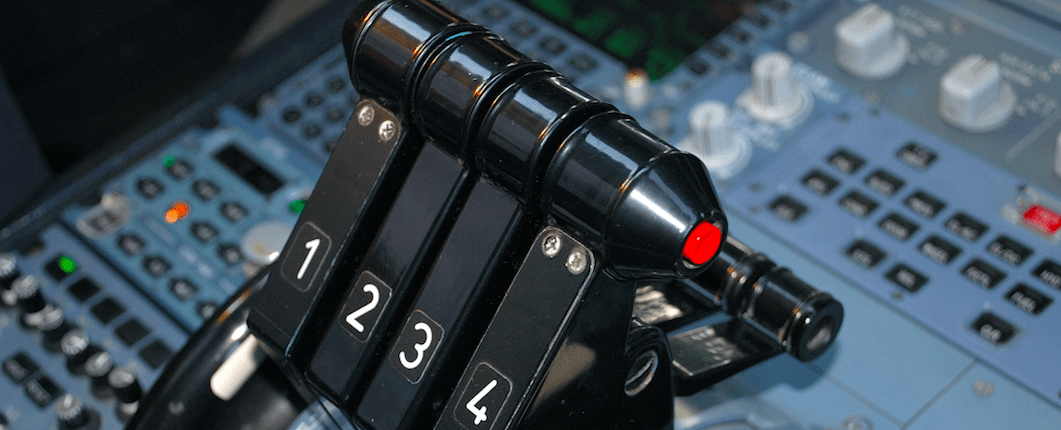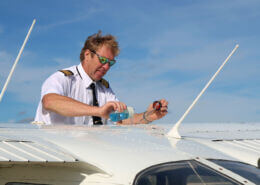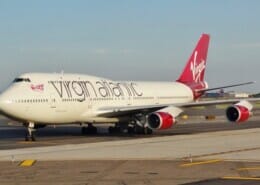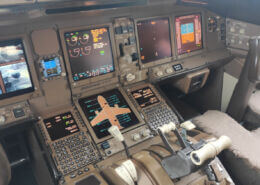The world of aviation abbreviations and acronyms is huge. More and more acronyms keep arriving and it will take an entire career to have heard and used them all! If you’ve got one in mind that you can’t find, give us at FlightDeckFriend.com an email and we’ll get it added.
A
AA – Acceleration Altitude
A/A – Air to Air
AA – Anti Aircraft
AA – American Airlines
AAIB – Air Accident Investigation Branch
AAL – Above Aerodrome Level
ALPHA – Angle of Attack
AB – Auto Brake
ABP – Able Bodied Passengers
AC – Alternating Current
A/C – Aircraft
ACARS – Aircraft Communication Addressing and Reporting System
ACN – Aircraft Classification Number
ACP – Auto Control Panel
AD – Airworthiness Directive
ADC – Air Data Computer
ADF – Automatic Direction Finder
ADI – Attitude Director Indicator
ADU – Air Data Unit
AFE – Above Field Elevation
AGL – Above Ground Level
AH – Artificial Horizon
AI – Altitude Indication
AIP – Aeronautical Information Publication
ALS – Approach Lighting System
ALT – Altitude
AMSL – Above Mean Sea Level
ANC – Aviate, Navigate, Communicate
AoA – Angle of Attack
AOC – Air Operators Certificate
AOG – Aircraft on Ground (due to a technical defect)
AOM – Airport Operating Minima
AP – Auto Pilot
AP – Aeroplane
APFDS – Auto Pilot Flight Director System
APP – Approach
APS – Airline Pilot Standard (MCC Course)
APT – Airport
APU – Auxiliary Power Unit
ANC – Aviate Navigate Communicate
ANP – Actual Navigation Performance
AR – Aspect Ratio
AR – Authorisation Required (RNAV Approaches)
ARP – Aerodrome Reference Point
ASDA – Accelerate Stop Distance Available
ASI – Airspeed Indicator
ASL – Above Sea Level
ASR – Airport Surveillance Radar
ASR – Air Safety Report
AT – Auto Throttle
ATA – Air Transport Association
ATC – Air Traffic Control
ATC – Air Training Corps
ATIS – Automatic Terminal Information Service
ATM – Air Traffic Management
ATP – Airline Transport Pilot
ATS – Air Traffic Service
ATPL – Air Transport Pilots Licence
ATZ – Air Traffic Zone
B
BA – Braking Action
BA – British Airways
BAA – British Airport Authority
BAA – Baltic Aviation Academy
BACF – British Airways Cityflyer
BALPA – British Airline Pilots Association
BARO – Barometric
BCS – Back Course (ILS)
BPR – By-Pass Ratio
BRK – Brookfield
BST – British Summer Time
BT – Backtrack
BTB – Back to Back
C
CA – Critical Area (ILS)
CAA – Civil Aviation Authority
CAE – A flight training organisation (OAA)
CAS – Calibrated Air Speed
CAT – Category (ILS)
CAT – Clear Air Turbulence
CAVOK – Ceiling and Visibility OK
CB – Circuit Breaker
CB – Cumulonimbus
CBT – Computer Based Training
CC – Cabin Crew
CC – Crew Control
CC – Company Council (BALPA Related)
CDA – Continuous Descent Approach
CDFA – Continuous Descent Final Approach
CDI – Course Deviation Indicator
CDU – Control Display Unit
CFI – Chief Flying Instructor
CFIT – Controlled Flight into Terrain
CGI – Chief Ground Instructor
CL – Center Line
CLB – Climb
CMD – Command
CMV – Converted Meteorological Visibility
COBT – Calculated Off Block Time
CoG – Centre of Gravity
CON – Contingency Fuel
CON – Max Continuos Thrust
CP – Chief Pilot / Cadet Program / Cadet Pilot
CP – Critical Point
CPDLC – Controller Pilot Data Link Communications
CPL – Commercial Pilots Licence
CPT – Captain
CRM – Crew Resource Management
CRMI – Crew Resource Management Instructor
CRZ – Cruise
CSM – Cabin Service Manager
CSS – Cabin Service Supervisor
CTC – British Integrated Flight Training Organisation
CTC – Chief Training Captain
CTOT – Calculated Take Off Time
CTR – Control Zone
CTZ – Control Zone
CVR – Cockpit Voice Recorder
CWS – Control Wheel Steering
CX – Checks
D
DA – Decision Altitude
DALR – Dry Adiabatic Lapse Rate
DC – Direct Current
DDG – Dispatch Deviation Guide
DEC – Direct Entry Captain
DER – Departure End (of the) Runway
DG – Dangerous Goods
DH – Decision Height
DI – Direction Indicator
DIV – Diversion
DLC – Data Link Clearance
DLR – Aptitude Testing Used by Lufthansa
DME – Distance Measuring Equipment
DNF – Did Not Fly
DODAR – Diagnose/Options/Decide/Assign/Review
DOC – Designated Operating Coverage
DOW – Dry Operating Weight
E
EASA – European Aviation Safety Agency
EAT – Estimated Approach Time
ECL – Electronic Checklist
EET – Estimated Elapsed Time
EFB – Electronic Flight Bag
EFIS – Electronic Flight Information System
EGT – Exhaust Gas Temperature
EGPWS – Enhanced Ground Proximity Warning System
EHSI – Electronic Horizontal Situation Indicator
ELT – Emergency Locator Transmitter
ELW – Estimated Landing Weight
EMB – Embraer
EMR – Emergency
EPR – Engine Pressure Ratio
ET – Elapsed Time
ETA – Estimated Time of Arrival
ETOPS – Extended-range Twin-engine Operational Performance Standards
ETOW – Estimated Take Off Weight
ETP – Emergency Turn Procedure
EZFW – Estimated Zero Fuel Weight
EZY – easyJet (ICAO Code)
F
FA – Flight Attendant
FATPL – Frozen Air Transport Pilots Licence
FAA – Federal Aviation Administration
FADEC – Full Authority Digital Engine Control
FAF – Final Approach Fix
FAP – Final Approach Point
FAR – Fedral Aviation Regulation
FAT – Final Approach Track
FBS – Fixed Based Simulator
FBT – Fixed Based Trainer
FBW – Fly By Wire
FCL – Flight Crew Licensing
FCOM – Flight Crew Operations Manual
FCTM – Flight Crew Training Manual
FD – Flight Director
FDR – Flight Data Recorder
FE – Flight Engineer
FF – Fuel Flow
FFS – Full Flight Simulator
FI – Flight Instructor
FIR – Flight Information Region
FIS – Flight Information Service
FLCH – Flight Level Change
FMA – Flight Mode Announciation
FMC – Flight Management Computer
FMS – Flight Management System
FNPT – Flight & Navigation Procedures Trainer
FO – First Officer
FOM – Fuel of Merit
FOD – Foreign Object Damage
FPA – Flight Path Angle
FPL – Filed Flight Plan
FPM – Feet Per Minute
FPP – Future Flyer Programme
FPT – Flat Panel Trainer
FPV – Flight Path Vector
FREQ – Frequency
FT – Flight Training
FTE – Flight Training Europe, Jerez
FTL – Flight Time Limitations
FTO – Flight Training Organisation
G
G – G-force
GA – General Aviation
G/A – Go Around
GAPAN – The Guild of Air Pilots & Air Navigators
GC – Great Circle
GE – General Electric
GENDEC – General Decleration
GH – General Handling
GI – Ground Instructor
GLONASS – Global Orbiting Navigation System
GND – Ground
GNSS – Global Navigation Satellite System
GP – Glide Path
GP – Guidance Panel
GPA – Glide Path Angle
GPS – Global Positioning System
GPWS – Ground Proximity Warning System
GS – Ground School
GS – Ground Speed
GS – Glide Slope
H
HDG – Heading
HDG SEL – Heading Select
HEA – High Energy Approach
HF – Human Factors
HF – High Frequency
HIALS – High Intensity Approach Lighting System
HIL – Hold Item List
HoT – Head of Training
HOT – Hold Over Time (Anti-icing)
HPA – Hectopascal
HP – Horse Power
HP – High Pressure
HPT – High Pressure Turbine
HSI – Horizontal Situation Indicator
HST – Hypersonic Transport
HUD – Head Up Display
HWC – Head Wing Component
HYD – Hydraulics
I
IAA – Irish Aviation Authority
IAC – Instrument Approach Chart
IAP – Instrument Approach Procedure
IAF – Initial Approach Fix
IALPA – Irish Airline Pilots Association
IAP – Instrument Approach Procedure
IAS – Indicated Air Speed
IATA – International Air Transport Association
IC – In Command
ICAO – International Civil Aviation Organisation
IDG – Integrated Drive Generator
IFR – Instrument Flight Rules
ILS – Instrument Landing System
IMC – Instrument Meteorological Conditions
INOP – Inoperative
INS – Inertial Navigation System
IR – Instrument Rating
IRS – Inertial Reference System
IRST – Instrument Rating Skills Test
IRU – Inertial Reference Unit
ISA – International Standard Atmosphere
ITCZ – Intertropical Convergence Zone
J
JAA – Joint Aviation Authorities
JAR – Joint Aviation Requirements
JFO – Junior First Officer
JOC – Jet Orientation Course
JS – Jump Seat
K
kHz – Kilohertz
KIAS – Knots Indicated Airspeed
KM – Kilometres
KPH – Kilometres per hour
KTS – Knots
L
LCC – Low Cost Carrier/s
LCK – Line Check
LCTR – Locator
LD – Landing Distance
LDA – Landing Distance Available
LDA – Low Drag Approach
LDR – Landing Distance Required
LG – Landing Gear
LHO – Live Human Organs
LHR – London Heathrow
LLZ – Localiser
LOC – Localiser
LOE – Line Orientated Exercise
LOFT – Line Oriented Flight Training
LORAN – Long Range Navigation
LNAV – Lateral Navigation
LP – Low Pressure
LPC – Line Proficiency Check
LRU – Line Replaceable Unit
LSK – Line Select Key
LSS – Local Speed of Sound
LST – Line Skills Test
LT – Line Training
LT – Local Time
LT – Leadership Team
LTC – Line Training Captain
LTP – Landing Threshold Point
LVL – Level
LVO – Low Visibility Operations
LVP – Low Visibility Procedures
LW – Landing Weight
M
MAA – Military Aviation Authority
MAA – Missed Approach Altitude
MAC – Mean Aerodyanamic Chord
MACG – Missed Approach Climb Gradient
MAP – Missed Approach Point
MATZ – Military Air Traffic Zone
MCC – Multi Crew Cooperation Course
MCP – Mode Control Panel
MCRIT – Critical Mach Number
MCT – Maximum Continuous Thrust
MDA – Minimum Decent Altitude
MDH – Minimum Decent Height
ME – Multi Engine
MEA – Minimum Enroute Altitude
MEL – Minimum Equipment List
MMEL – Master Minimum Equipment List
MEP – Multi Engine Piston
MET – Meteorological
METAR – Meteorological Aerodrome Report
MFRA – Minimum Flap Retraction Altitude
MLM – Maximum Landing Mass
MLS – Microwave Landing System
MLW – Maximum Landing Weight
MM – Middle Marker
MMO – Maximum Mach Number
MOA – Memorandum of Agreement
MOC – Minimum Obstacle Clearance
MOR – Mandatory Occurance Report
MORA – Minimum En-route Altitude
MPA – Multi Pilot Aircraft
MPL – Multi-Crew Pilots Licence
MPS – Meters Per Second
MRO – Maintenance, Repair and Overhaul
MRW – Maximum Ramp Weight
MSA – Minimum Sector/Safe Altitude
MSL – Mean Sea Level
MTOW – Maximum Take Off Weight
MZFW – Maximum Zero Fuel Weight
N
N1 – Low Pressure Compressor Speed
N2 – High Pressure Compressor Speed
NADP – Noise Abatement Departure Procedure (1 or 2)
NAT – North Atlantic
NAT-OTS – North Atlantic Organised Track System
NATS – North Atlantic Track System
NATS – National Air Traffic Service
NAV – Navigation
ND – Navigation Display
NDB – Non Directional Beacon
NG – Next Generation
Nigel – A British Airways Pilot (Slang)
NM – Nautical Mile
No1 – Number One (Senior Cabin Crew Member)
NOTAM – Notice to Airmen
NOTECH – Non Technical Skills
NPA – Non-Precision Approach
NPPL – National Private Pilots Licence
NSC – No Significant Cloud
NTS – Non Technical Skills
NTSB – National Transportation Safety Board
NWS – Nose Wheel Steering
O
OAA – Oxford Aviation Academy (UK Integrated School)
OAT – Outside Air Temperature
OB – Off/On Blocks
OBS – Omni Bearing Selector
OC – Operations Control
OCA – Obstacle Clearance Altitude
OCA – Oceanic Control Area
OCC – Operators Conversion Course
OCH – Obstacle Clearance Height
OEA – One Engine Approach
OEI – One Engine Inoperative
OEM – Original Equipment Manufacturer
OFP – Operational Flight Plan
OM – Operations Manual
OM – Outer Marker
OPC – Operator Proficiency Check
OTP – On Time Performance
OTS – Organised Track System
OTS – Out of Service
QTY – Quantity
OW – Operational Weight
OXY – Oxygen
O2 – Oxygen
P
P1 – Pilot in Command
P2 – Pilot Second in Command
PA – Public/Passenger Announcement
Packs – Air Conditioning Units
PANS-OPS – Procedures for Air Navigation Services
PAPI – Precision Approach Path Indicator
PAR – Precision Approach Radar
PAX – Passenger/s
PBN – Performance Based Navigation
PCN – Pavement Classification Number
PDC – Pre-departure Clearance
PET – Point Of Equal Time
PF – Pilot Flying
PFD – Primary Flight Display
PFL – Practice Forced Landing
PIC – Pilot in Command
PICUS – Pilot in Command Under Supervision
PIO – Pilot Induced Oscillations
PIREP – Pilot Report
PoB – Passengers on Board
PoF – Principles of Flight
POH – Pilot’s Operating Handbook
PM – Pilot Monitoring
PNF – Pilot Not Flying
PNR – Point of No Return
PPL – Private Pilots Licence
PPR – Prior Permission Required
PRNAV – Precision Area Navigation
PSI – Pressure per square inch
PSR – Point of Safe Return
PSR – Purser (No 1 Cabin Crew)
PT – Progress Test
PTT – Push to Talk
PUT – Pilot Under Training
Q
QDM – Magnetic heading to a station
QDR – Magnetic Bearing from a station
QFE – Field Elevation (Pressure Setting)
QNH – Regional Pressure Setting
QRA – Quick Reaction Alert
QRH – Quick Reference Handbook
R
RA – Radio Altimeter
RA – Radio Altitude
RA – Resolution Advisory
RAD ALT – Radio Altimeter
RADAR – Radio Detection and Ranging
RAF – Royal Air Force
RAS – Rectified Airspeed
RAT – Ram Air Turbine
REL – Runway Edge Lights
RESA – Runway End Safety Area
RET – Rapid Exit Taxiway
RFFS – Resuce & Fire Fighting Services
RMI – Radio Magnetic Indicator
RN – Royal Navy
RNAV – Area Navigation
RNP – Required Navigation Performance
RPL – Repetitive Flight Plan
RPM – Revolutions Per Minute
RT – Radio Telephony
RTB – Return to Base
RTFQ – Read The F**k**g Question
RTO – Rejected Take Off
RTS – Return to Stand
RTS – Return to Service
RVR – Runway Visual Range
RVSM – Reduced Vertical Separation Minima
RW – Runway
RWY – Runway
S
SADLR – Saturated Adiabatic Lapse Rate
SAR – Search and Rescue
SAT – Saturated Air Temperature
SATCOM – Satellite Communication
SCCM – Senior Cabin Crew Member
SE – Single Engine
SELCAL – Selective Calling
SEP – Single Engine Piston
SEP – Safety and Emergency Procedures
SFI – Synthetic Flight Instructor
SFO – Senior First Officer
SHF – Super High Frequency
SIC – Second In Command
SID – Standard Instrument Departure
SIGMET – Significant meteorological advisory
SLF – Self Loading Freight (Passengers)
SLOP – Strategic Lateral Offset Procedures
SLP – Speed Limit Point
SM – Statute Mile
SMR – Surface Movement Radar
S/O – Second Officer
SOP’s – Standard Operating Procedures
SOS – Save our Souls (Distress call)
SPIC – Student Pilot In Command
SR – Sunrise
SRA – Surveillance Radar Approach
SS – Sunset
SSR – Secondary Surveillance Radar
SST – Supersonic Transport
STA – Scheduled Time of Arrival
STAR – Standard Terminal Arrival Route
STD – Scheduled Time of Departure
STD – Standard (Pressure Setting 1013mb)
T
TA – Transition Altitude
TA – Traffic Advisory
TAA – Terminal Arrival Area
TAA – Terminal Arrival Altitude
TACAN – Tactical Air Navigation
TAF – Terminal Area Forecast
TAF – Aerodrome Forecast
TAFB – Time Away From Base
TAS – True Airspeed
TAT – Total Air Temperature
TCA – Terminal Control Area
TCAS – Traffic Collision Avoidance System
TCH – Threshold Crossing Height
TDZ – Touch Down Zone
TECH – Technical
TEM – Threat and Error Management
TERPS – Terminal Procedures
TFC – Traffic
THOB – Total Heads On Board
THLD – Threshold
THLD – Thrust Hold
THR – Threshold
TKI – Theoretical Knowledge Instructor
TL – Transition Level
TLA – Thrust Lever Angle
TMA – Terminal Manoeuvring Area
TMI – Track Message Identification
T/O – Take Off
TO/GA – Take Off Go Around
TOC – Take Off Configuration
TOC – Top Of Climb
TOD – Top Of Descent
TODA – Take Off Distance Available
TORA – Take Off Run Available
TOW – Take Off Weight
TP – Turbo Prop
TR – Type Rating
TRE – Type Rating Examiner
TRI – Type Rating Instructor
TRTO – Type Rating Training Organisation
TRU – Transformer Rectifier Unit
TS – Thunderstorm
TT – Total Time
TTL – Total
TWC – Tail Wind Component
TWR – Tower
TWY – Taxiway
U
UA – Unusual Attitude
UAS – University Air Squadron
UAV – Unmanned Air Vehicles
UFO – Unidentified Flying Object
UHF – Ultra High Frequency
UIR – Upper Flight Information Region
U/S – Unserviceable
USAF – United States Air Force
UTC – Universal Co-ordinated Time (Zulu)
V
VA – Virgin Atlantic
VAAC – Volcanic Ash Advisory Center
VAC – Volcanic Approach Chart
VASI – Vertical Approach Slope Indicator
VFE – Maximum Flap Extension Speed
VFR – Visual Flight Rules
VHF – Very High Frequency
VIP – Very Important Person
VIMD – Maximum Drag Speed
VLE – Maximum Landing Gear Extended Speed
VMC – Visual Meteorological Conditions
VMCA – Minimum Control Speed Airborne
VMCG – Minimum Control Speed Ground
VMO – Maximum Indicated Airspeed
VNAV – Vertical Navigation
VNE – Never Exceed Speed
VNO – Normal Operating Speed
VOLMET – Meterlogical Information In Flight
VOR – VHF Omni Directional Radio Range
VR – Rotate
VRB – Variable
VS – Vertical Speed
VSI – Vertical Speed Indicator
VTOL – Vertical Take Off and Landing
VIP – Very Important Person
VV – Vertical Visability
VVIP – Very Very Important Person
VX – Best Angle of Climb Speed
VY – Best Rate of Climb Speed
W
WILCO – Will Comply
WIP – Work In Progress
WOCL – Window of Circadian Low
WPT – Way Point
X
WX – Weather
XPDR – Transponder
XWC – Cross Wind Component
Z
Z – Zulu Time (Same as UTC and GMT)
ZFT – Zero Flight Time
ZFW – Zero Fuel Weight



 Shutter Stock
Shutter Stock

 ShutterStock
ShutterStock Shutter Stock
Shutter Stock